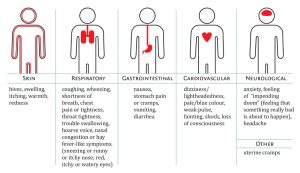Whether you are new to allergies or you’ve been managing them for years, it’s important to review the signs of anaphylaxis, and what to do in case of a reaction. Experts agree that if someone is having a reaction, you need to first give them epinephrine, then call 911. You can do it!
The following information is medically-reviewed by allergists and comes from our website. Please feel free to share it with friends and family.
What does a reaction look like?
Did you know that a person can have a reaction without having hives? In fact, reactions can look different each time, even in the same person. People may have different ways of describing a reaction, too. For example, a child may describe their symptoms different than an adult: for example “my throat is tingly” or “my tongue feels scratchy”.
Sometimes an allergic reaction is sudden and severe. Other times, it can start with mild symptoms (such as feeling generally unwell) and then get worse quickly. A reaction can also occur hours after the first reaction. This is known as a biphasic reaction.
Learn more about the symptoms of anaphylaxis.
What are the steps to take during a reaction?
Important note: Use the epinephrine auto-injector first, then call 911. Practice here
Step 1: Give epinephrine at the first signs of an allergic reaction.
Step 2: After giving epinephrine, call 911 or your local emergency medical services and tell them that someone is having an anaphylactic reaction.
Step 3: Give a second dose of epinephrine as early as 5 minutes after the first dose if there is no improvement in symptoms.
Step 4: Go to the nearest hospital right away (ideally by ambulance), even if symptoms are mild or have stopped. The reaction could get worse or come back.
Step 5: Call the person’s emergency contact.
Body Positioning
Body position is an important but overlooked area of care. Place the person on their back with their legs raised while waiting for the ambulance. If they are vomiting, nauseated or have fainted, place them on their side.
Do not have the person sit up, stand up, or walk to the ambulance. This can cause dangerous complications. Travel to the hospital together. The hospital will treat and monitor symptoms.
You can do it
If you have never helped someone who is having anaphylaxis, don’t worry. Auto-injectors come with simple instructions. The medication is life saving. See the .pdf below for more information.
If you have had the experience of helping another person during an allergic reaction, we’d like to thank you – and ask you to please share your experience and teach others! Together we can manage food allergies and be prepared in any situation.
- Download the 5 Emergency Steps as a .pdf.
- For parents
- Canadian Allergists statement on epinephrine for babies and toddlers
Tags: auto-injector, emergencies, Epinephrine, EpiPen, what does a reaction look like

